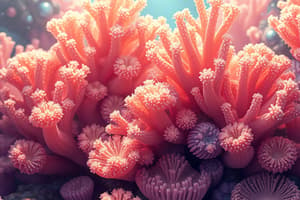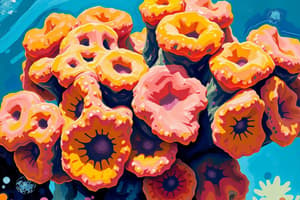Podcast
Questions and Answers
Qual es le principale modo in le quale le sponges obtine alimento?
Qual es le principale modo in le quale le sponges obtine alimento?
- Cace organismos microscopic
- Filtra particulas de alimento del aqua (correct)
- Absorbe alimento directemente del aqua
- Utilisa collagene pro attraher alimento
Qual es le function del porocytes in le structure del sponge?
Qual es le function del porocytes in le structure del sponge?
- Controlla le fluxo de aqua per le ostia (correct)
- Digestione de alimento captate
- Protege le sponge contra predatores
- Produce flagella pro mover aqua
Qual es le taxa de clearance de Spongia officinalis var.adriatica?
Qual es le taxa de clearance de Spongia officinalis var.adriatica?
- 500 ml h−1 g−1 DW
- 210 ml h−1 g−1 DW (correct)
- 50 ml h−1 g−1 DW
- 1000 ml h−1 g−1 DW
Como le sponges respira e excrete?
Como le sponges respira e excrete?
Qual es le rol del amebocytes in le sponge?
Qual es le rol del amebocytes in le sponge?
Qual es un modo d'ape reproductor que sponges usa?
Qual es un modo d'ape reproductor que sponges usa?
Quot sponges species es tipicamente monoecious?
Quot sponges species es tipicamente monoecious?
Qual tipo de larvas es solid?
Qual tipo de larvas es solid?
Qual es un benefici ecologic de sponges?
Qual es un benefici ecologic de sponges?
Qual es un uso commercial de sponges?
Qual es un uso commercial de sponges?
Quo significa 'Porifera'?
Quo significa 'Porifera'?
Qual caracteristica ha le sponges?
Qual caracteristica ha le sponges?
Qual classe de sponges ha spicules de carbonato de calcio?
Qual classe de sponges ha spicules de carbonato de calcio?
Quo distingue le choanocytes in le sponges?
Quo distingue le choanocytes in le sponges?
Qual classe de sponges ha siliceous spicules e es tipicamente marine?
Qual classe de sponges ha siliceous spicules e es tipicamente marine?
Quo es le design structural de Venus’ flower basket utilizate in?
Quo es le design structural de Venus’ flower basket utilizate in?
Quale spicules permite le passage de luce intra cavitates obscure pro symbiontes photosyntheticos?
Quale spicules permite le passage de luce intra cavitates obscure pro symbiontes photosyntheticos?
Qual es le characteristicas de sponges in termino de embryologia?
Qual es le characteristicas de sponges in termino de embryologia?
Qual classe de esponjas ha spicules siliceous non 6-rayed?
Qual classe de esponjas ha spicules siliceous non 6-rayed?
Qual es la structura de choanoderm de un esponja asconoid?
Qual es la structura de choanoderm de un esponja asconoid?
Quando considerante l'ogulin cave sponge, quale statement es ver?
Quando considerante l'ogulin cave sponge, quale statement es ver?
Qual es le forma tipic de un sponge leuconoid?
Qual es le forma tipic de un sponge leuconoid?
Qual de iste enunciatos es correcte in relation con le spicules de Demospongiae?
Qual de iste enunciatos es correcte in relation con le spicules de Demospongiae?
Qual sponge tipic es usual in diverse habitats aquos?
Qual sponge tipic es usual in diverse habitats aquos?
Quant es le maximum de grandezza generalmente associate con le esponjas asconoid?
Quant es le maximum de grandezza generalmente associate con le esponjas asconoid?
Quo es le function de spicules in Demospongiae?
Quo es le function de spicules in Demospongiae?
Flashcards are hidden until you start studying
Study Notes
Phylum Porifera: Sponges
- Sponges are known as "pore-bearing" organisms.
- Classified as parazoans; they lack true embryological germ layers.
- Multicellular, with totipotent cells, but true tissues are absent.
- They are sessile, functioning as suspension feeders with a specialized water canal system.
Characteristics of Sponges
- Exhibit asymmetrical or +/- radial symmetry.
- Unique cells called choanocytes create water currents for feeding.
Sponge Skeleton & Taxonomy
- Skeleton comprises spicules:
- Calcium carbonate spicules belong to Class Calcarea.
- Hexactinellida features siliceous, 6-rayed spicules.
- Class Demospongiae has siliceous spicules that are not 6-rayed or may consist of collagen (spongin).
Class Calcarea
- Characterized by calcium carbonate spicules, all marine.
- Includes species such as Leucosolenia eleanor.
Class Hexactinellida
- Identified by 6-rayed siliceous spicules, predominantly found in deep marine waters.
- Commonly referred to as glass sponges.
Structural Design of Glass Sponges
- Structural designs inspired civil and mechanical engineering breakthroughs.
- Known for light transducing properties, allowing photosynthetic symbionts to thrive in dark environments.
Class Demospongiae
- Comprises sponges with siliceous spicules, not 6-rayed.
- Can have a collagenous network replacing spicules.
- Habitat ranges include marine, brackish, and freshwater environments at varying depths.
Sponge Body Plans
- Asconoid: Simple structure, choanoderm one cell thick, small in size.
- Syconoid: Features folded choanoderm, typical of calcareous sponges.
- Leuconoid: Divided choanoderm into distinct chambers, most common in demosponges.
Feeding Mechanism
- Filter feeders; water enters through ostia, controlled by porocyte cells.
- Water movement is partly passive; choanocytes actively help in water propulsion.
- Sponges can filter high volumes of water, with some able to filter an entire sea volume in one day.
Nutrition
- Food particles are captured by choanocytes and transferred to amebocytes for digestion.
- Phagocytosis occurs on the surface of choanocytes.
Reproductive Strategies
- Asexual reproduction via fragmentation, budding, or gemmules, which are survival pods for freshwater sponges.
- Most sponges are monoecious, with sperm from choanocytes and eggs from archeocytes.
- Mass spawning occurs during reproduction.
Sponge Larvae
- Produce two types of larvae: parenchymella (solid) and amphiblastula (hollow), both are ciliated.
Ecological Success & Importance
- Sponges are prevalent in unpolluted freshwater and abundant in marine environments.
- They support various symbiotic relationships, provide camouflage, and contribute to bioerosion via specialized cells.
Economic Importance
- Bath sponges are harvested commercially, notably in the Mediterranean and Tarpon Springs, Florida.
Studying That Suits You
Use AI to generate personalized quizzes and flashcards to suit your learning preferences.




